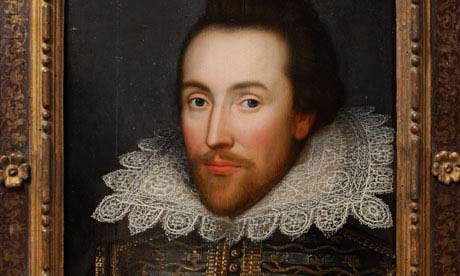|
 An image of Shakespeare. The discounted claims of an 18th- century author to have re-shaped the words of Shakespeare into a play are finally being taken seriously by a respected publisher of the Bard's works nearly 300 years on.
|
|
The discounted claims of an 18th- century author to have re-shaped the words of Shakespeare into a play are finally being taken seriously by a respected publisher of the Bard's works nearly 300 years on. Double Falsehood, a play written by Lewis Theobald and first performed in 1727, was based substantially on another work co-written by William Shakespeare more than a century earlier, a leading academic said on Tuesday. Adding weight to the claim of Professor Brean Hammond of Nottingham University is the fact that the respected Arden Shakespeare publishers will release it in print on March 22. Its appearance, and the attribution to Shakespeare, is likely to trigger another round of scholarly debate over what the English-speaking world's most famous and influential playwright wrote and what was falsely attributed to him. For Hammond, the publication of the play next week will be the culmination of years of research. "I started working on it in the 1980s and wrote a couple of articles on the play," he said. Theobald always claimed his play was based on a lost version by Shakespeare that was in turn based on the story of Cardenio, taken from the novel Don Quixote, by Spanish author Miguel de Cervantes. Hammond said modern scholarship had established that the early work, performed in 1613, was co-written by Shakespeare and John Fletcher. Theobald then substantially re-worked and cut it, meaning the presence of three hands in the present version. "Shakespeare wrote most of the first half (of the original) and Fletcher wrote most of the second half - you could detect a new hand from the style of writing," Hammond said. Theobald's work, a story of love and betrayal, was popular with 18th-century audiences, but the playwright was widely dismissed as a fraudster for claiming he had used the words of Shakespeare. "The play has been rubbished in the past," Hammond said. "It did have a successful theatrical run when it came out, but soon after people began asking questions and thought that it was not a single author play by Shakespeare and we know that it's not." That interpretation became widely accepted and the play has languished in relative obscurity until now, when the work will be widely accessible for the first time in more than 250 years. "What's left in it now for the modern reader is Shakespeare's DNA," Hammond said. (Read by Lee Hannon. Lee Hannon is a multimedia journalist at the China Daily Web site.) (Agencies) |
日前,一部據(jù)稱(chēng)為18世紀(jì)一名作家根據(jù)莎士比亞作品改編而成的戲劇終于在近三百年后被莎士比亞作品權(quán)威出版商驗(yàn)明真身。 據(jù)一名主要研究人員本周二介紹,這部名為《愛(ài)情騙徒》的戲劇由劉易斯?希爾包德改編,并于1727年被首次搬上舞臺(tái)。經(jīng)考證,這部戲劇大部分根據(jù)一個(gè)多世紀(jì)以前威廉?莎士比亞與人合著的另一劇作改編而成。 莎士比亞作品權(quán)威出版商“亞頓”將于本月22日出版該劇作,這為諾丁漢大學(xué)布里恩?哈蒙德教授有關(guān)這一問(wèn)題的說(shuō)法增加了籌碼。 這部劇作的面世及其為莎翁所創(chuàng)的說(shuō)法將可能激起新一輪有關(guān)哪些劇作為這位英語(yǔ)文學(xué)界最著名和最具影響力的劇作家真正所創(chuàng),哪些又確為贗品的學(xué)術(shù)爭(zhēng)論。 對(duì)于哈蒙德來(lái)說(shuō),下周這部作品的出版將使多年來(lái)有關(guān)這一問(wèn)題的研究達(dá)到頂峰。他說(shuō):“我從上世紀(jì)80年代開(kāi)始研究這部劇作,就此寫(xiě)了很多文章。” 希爾包德當(dāng)時(shí)一直聲稱(chēng)這部劇作改編自莎翁一部失傳的劇作,而莎翁的原創(chuàng)又取材于西班牙文學(xué)巨匠米格爾?德?塞萬(wàn)提斯名著《堂吉珂德》中的卡登尼歐的故事。 哈蒙德稱(chēng),現(xiàn)代研究已證實(shí),這部于1613年首演的作品為莎士比亞與約翰?佛萊契爾合著。之后,希爾包德對(duì)其進(jìn)行了大量的改編和刪減,導(dǎo)致目前的版本中出現(xiàn)了三種筆法。 哈蒙德說(shuō):“莎士比亞主要撰寫(xiě)了原著的前半部分,佛萊契爾則主要寫(xiě)了后半部分。這可以從文風(fēng)上看出來(lái)。” 希爾包德改編的這部關(guān)于愛(ài)情和背叛的作品在18世紀(jì)時(shí)很受觀(guān)眾喜愛(ài),但由于他稱(chēng)其根據(jù)莎翁作品改編而成,因此被斥為騙子。 哈蒙德說(shuō):“這部劇作一直受到貶損。它最初被搬上舞臺(tái)時(shí)非常成功,但不久之后人們開(kāi)始提出疑問(wèn),認(rèn)為這不是莎翁獨(dú)創(chuàng)的作品,現(xiàn)在我們知道它的確不是。” 這種說(shuō)法逐漸被廣泛接受,而這部劇作在250年后的今天才得以重見(jiàn)天日,與廣大讀者見(jiàn)面。 哈蒙德說(shuō):“現(xiàn)代讀者還能從中找到莎翁的影子。” 相關(guān)閱讀 Shakespeare: Master of Tragedy 悲劇大師 Shakespeare's Globe Theatre 莎士比亞環(huán)球劇場(chǎng) Shakespeare the Historian 史學(xué)家的莎士比亞 (中國(guó)日?qǐng)?bào)網(wǎng)英語(yǔ)點(diǎn)津 Julie 編輯蔡姍姍) |
|
Vocabulary: discount:to leave out of account; disregard(懷疑地對(duì)待,漠視) the Bard:莎士比亞的別稱(chēng),也稱(chēng)為the Bard of Avon,bard一般用來(lái)指吟游詩(shī)人。 fraudster:one who commits fraud(騙子,犯欺詐罪者) |
